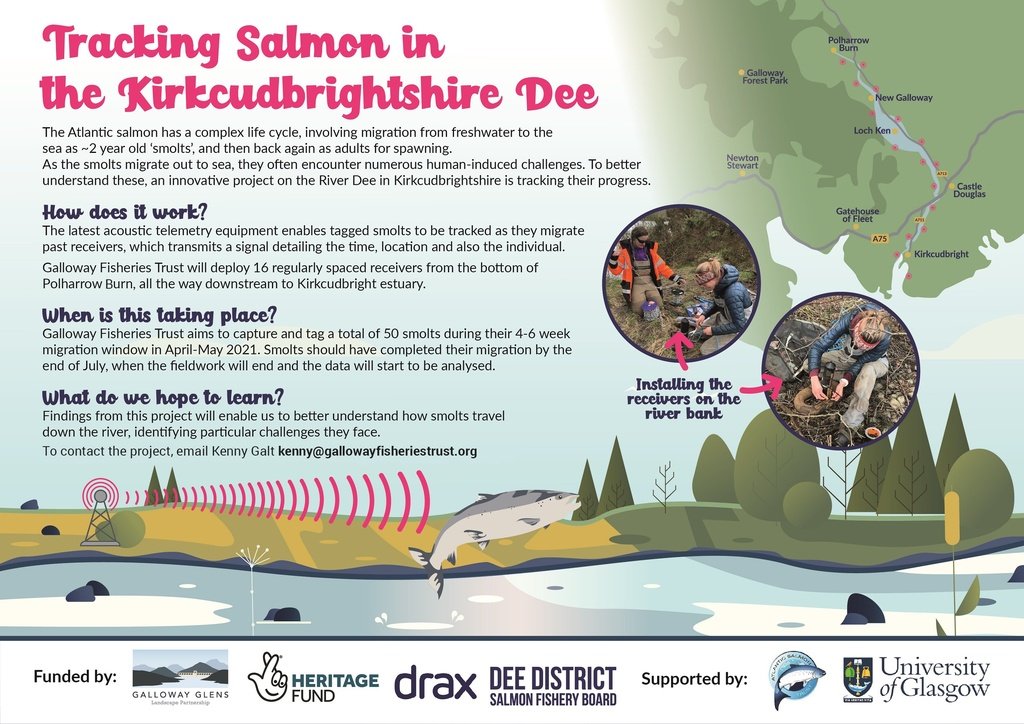Tracking a Second Year of Salmon Migration in Galloway
PRESS RELEASE FROM GALLOWAY GLENS LANDSCAPE PARTNERSHIP
In 2021, the first phase of a salmon smolt tracking project took place, with young salmon tagged and monitored as they travelled down the Ken/Dee River system in Galloway. This gave a lot of information about how Salmon navigate down the river, with 58% of the tagged salmon smolts making it to the Inner Estuary.
Building on the 2021 study, work has been underway in recent months to track the 2023 migration of smolts down the river, with a further 40 smolts tagged this year in advance of their trip downstream.
The work was led by Galloway Fisheries Trust, supported by Drax – the owners of the Galloway Hydro Scheme, The Galloway Glens Scheme, University of Glasgow, the Dee (Kirkcudbrightshire) District Salmon Fishery Board, Scottish Environment Protection Agency (SEPA) and Forestry & Land Scotland.
The journey of the tagged salmon is tracked using 33 receivers installed along the banks of the river, with data then analysed by the GFT and Glasgow University teams. Plans are afoot for this to be repeated in 2024, building an increasingly reliable and comprehensive data set.
The study focused on the capture of juvenile salmon at the point of smoltification (the point at which salmon start changing their physiology from being a freshwater fish and readying themselves to live in the marine environment) and tracking their movement down through the river system.
Salmon smolts are relatively small and vulnerable to predation by larger fish such as pike, fish eating birds such as goosanders and mammals such as otters. The longer they spend on the migration the more vulnerable they are, this project looks at the mortality of the fish through the system and the length of time it took to undertake this journey, including past dams and other impoundments.
Salmon smolt
Forty fish were caught and tagged with small acoustic devices which sent a signal to receivers that were placed down the river system. Thirty three receivers were spread out from just below the Polharrow Burn (north of Dalry) all the way down to Kirkcudbright.
A project of this nature is only possible as recent advances in technology have managed to ‘miniaturise’ transmitters and batteries so they do not influence the swimming ability of small fish like salmon smolts.
Salmon used to be abundant across the Solway and the River Dee was, arguably, one of the most productive of these rivers.
Impoundments built on the river in the 1930s to harness energy had a large effect upon the ability of salmon to migrate through the system, both for smolts moving downstream and adult salmon ascending the river.
Fish passage was considered during the construction of many of the dams with fish ladders built but understanding downstream migration of smolts has been more difficult.
A short, non-technical summary of the 2021 work has been published and is available here: https://gallowayglens.org/wp-content/uploads/2022/11/Kirkcudbrightshire-Dee-Salmon-Migration-Study-2021-summary.pdf. The 2023 works were also supported using funds from the Scottish Government’s Nature Restoration Fund.
Checking the fyke box.
Jamie Ribbens, Senior Biologist at Galloway Fisheries Trust, said:
“The 2021 study produced some very interesting results regarding how salmon smolts travel down the Dee system on their way to the estuary. This further study aims to understand in more detail how the fish are behaving under different conditions to investigate what could be done to ease their migration and thus maximise the numbers of smolts able to leave the Dee successfully. We need everyone working together to restore the salmon population in the Dee. It is good to be working with Glasgow University again on this important study and we appreciate that both DRAX and Galloway Glens have continued to supported the research.”
Equipment installed in river.
Martin McGhie, Drax’s Manager of the Galloway & Lanark Hydros, added:
“Gaining a better understanding of how species such as Salmon interact with our hydro-electric scheme is a key factor in helping us improve the ecology within the Ken-Dee catchment. The 2021 smolt tagging trials provided a fascinating insight into the journey the smolts take on their journey down through the river system. We are delighted to help fund further and expanded research which will hopefully build on the first trial and provide greater understanding of this process.”
Nick Chisholm, Galloway Glens Project Officer, added:
“It’s great to see that a little bit of support from our National Lottery Funding and inspirational leadership from the Galloway Fisheries Trust allow us to unlock some of the salmon’s travel itinerary. The information that is gathered from this will be incredibly valuable and help the operator of the hydro scheme manage water flow for the salmon’s benefit. Dam fine work everyone!!”
Jamie Ingall, Chairman of the Dee District Salmon Fishery Board, said:
“The initial smolt tracking project provided some important insights into the challenges faced by migrating salmon in the Dee (Kirkcudbrightshire) river system, however the data was limited and therefore could not be conclusive. This second phase will enable us to complete the picture and we are grateful to Drax and Galloway Glens for providing the necessary funding, as well as GFT and Glasgow University for their hard work in tagging and tracking the smolts in difficult conditions.”
Dr Scot Mathieson, Fish and Biodiversity Unit Manager at SEPA, said:
“SEPA continues to work closely with partners, fishery trusts and businesses in the catchment area to improve rivers and manage pressures on migratory fish. It was extremely interesting to see survival rates and the routes salmon smolts were taking through parts of the Galloway Hydro Scheme following the first tracking study on the Dee in 2021, and we are encouraged that this work is set to continue to build a more robust picture. The data and information this study provides will be a valuable, additional resource for exploring options to ease smolt migration downstream.”
McNabb Laurie, Galloway Glens Landscape Partnership




